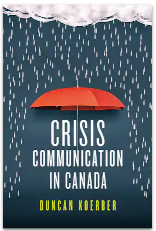Theory and Questions of the Archives Unleashed Niagara Region COVID-19 Dataset
In this Archives Unleashed project, our team will be analyzing the Niagara Region COVID-19 dataset from the perspective of crisis communication theory. Crisis communication is a relatively young field by most standards, extending back just about 30 years. Back then, crisis communication researchers began with small-scale case studies of response messaging from individual organizations. The main question was this: Did the organization respond effectively to a crisis? If not, what could the organization have done better?
Today, one trend in the field is towards computational analysis of very large datasets to go beyond the study of the individual organizational case. Looking at broader datasets can make eventual findings more significant – it’s not just one case. Our Niagara Region COVID-19 dataset is so big – gigabytes of website and social media data from many regional organizations – that computational analysis allows us to deal with and examine crisis messaging more systematically and on a broader scale. This analysis allows us to ask all kinds of important questions of the dataset and come to new, significant conclusions that further crisis communication theory. In turn, we hope practitioners can use these findings to deal effectively with the next mega crisis.
But first we have to ask questions that link past crisis communication theory with our dataset. Past research in the field on these mega crises falls into a few main themes:
- how crisis communication messaging contributes to community resilience;
- the development of public trust;
- education about and compliance with public health recommendations;
- public engagement with organizations. Researchers have also considered the factor of emotions in public messaging and messaging consistency and congruence during mega crises.
With these themes in mind, here are some of the questions we’re thinking about asking of the Niagara Region COVID-19 dataset:
-
Did private and public Niagara Region organizations communicate similar messages and advice to the public during the pandemic? Was there “one voice” across the region or diverging voices?
-
Was the purpose of communication instructional or emotional?
-
If the messages were instructional, were the instructions consistent across organizations (re. masking, social distancing, vaccination etc.)?
-
Did organizational messaging change over time in terms of content and emotional sentiment?
-
Were messages to the public simple or complicated?
-
How much of the message content was about organizational status versus community building?
-
Did organizations foreground messages from their leaders? Or did they speak as a ‘faceless’ organization?
-
Did organizations tell stories about the pandemic or just stick to the facts about COVID-19?
-
Did the emotions of the messages change over time, reflecting developments in the pandemic?
These questions are exploratory in nature and quite broad at this time. But in the near future, as we start to dig into the dataset, we’ll be able to determine whether the questions can be answered at all. Most likely, computational analysis will favour some questions over others, and we can start moving more fully in a few of these directions. And those findings should provide some interesting, useful guidance for public relations practitioners, perhaps even as the pandemic continues into the winter of 2022.
Duncan Koerber is the author of Crisis Communication in Canada published by University of Toronto Press, and is available in the Brock Library Collection
